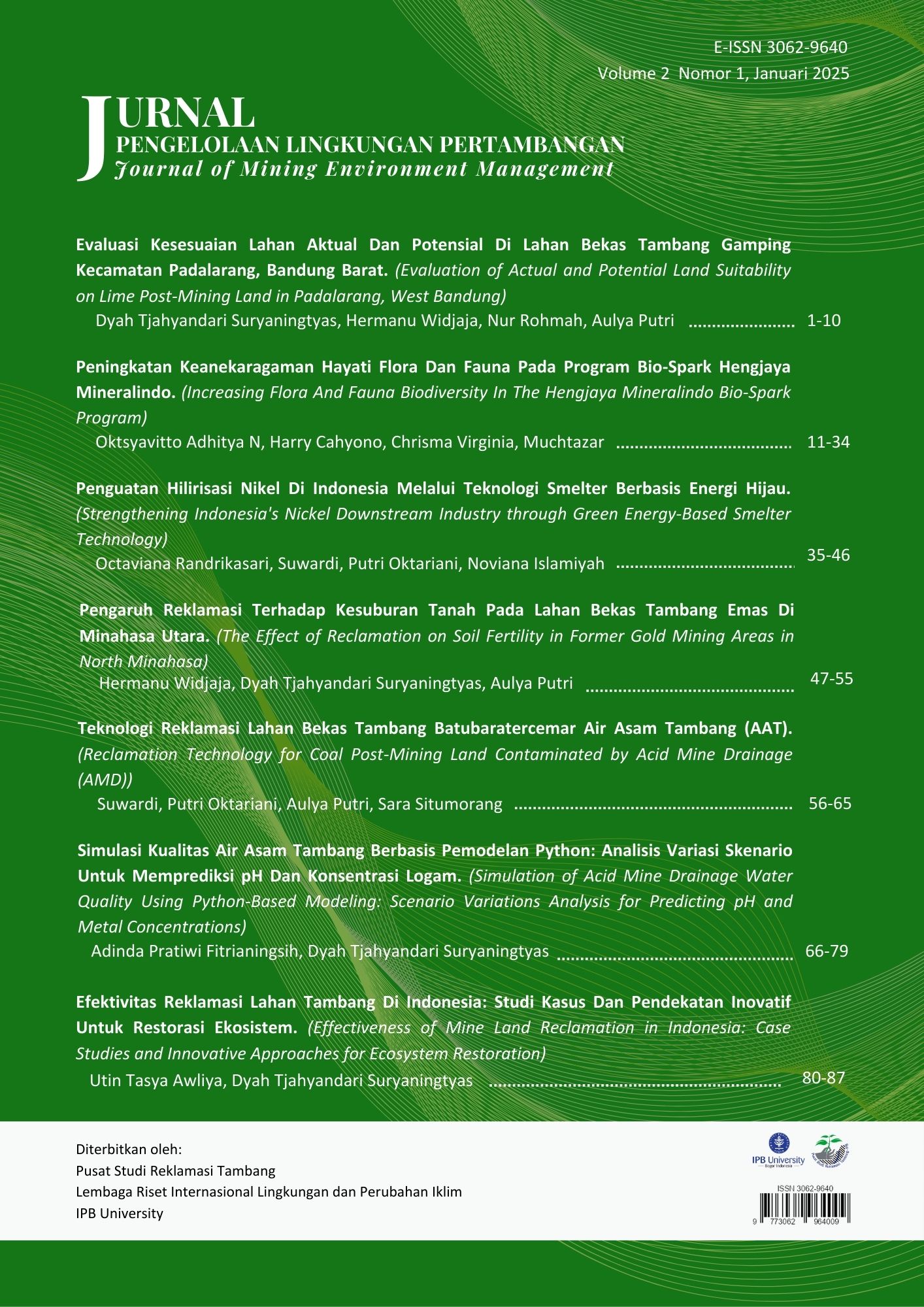Evaluation of Actual and Potential Land Suitability on Lime Post-Mining Land in Padalarang, West Bandung
Abstract
Open Access Land (OAL) refers to former mining areas outside the mining business license zones, which often experience severe degradation due to illegal mining activities without reclamation. The negative impacts of mining activities on OAL must be addressed promptly through reclamation efforts. Developing a rehabilitation plan for OAL requires comprehensive data, including land suitability evaluation data. This study was conducted on former limestone mining areas in the Gunung Hawu-Pabeasan region, Padalarang, West Bandung Regency, with the objective of assessing current and potential land suitability, identifying limiting factors, and providing rehabilitation recommendations. Soil samples were collected from four distinct locations, including natural soil and OAL sites (1,2, and 3), and analyzed in the laboratory to determine soil characteristics. The analysis revealed significant differences between natural soil and OAL, particularly in terms of effective depth, soil physical and chemical properties. Land suitability evaluation based on FAO guidelines, indicated that natural soil is classified as marginally suitable (S3) for certain crops compared to OAL, with main limiting factors including nutrient retention and water availability. OAL soils are mostly classified as not suitable (N) for the studied crops, primarily due to limitations in effective soil depth and water availability. OAL requires further improvements to enhance land suitability through fertilization and proper root zone management. After rehabilitation, the potential land suitability improves but remains in S2 and S3 classes depending on the type of crop. Teak, sengon, and pine are suitable for revegetation but still require proper land management and improvement to enhance land suitability
References
Al Basri, A. (2013). Desain Agroforestri pada Lahan Kritis Di Desa Kayu Loe Kecamatan Bantaeng Kabupaten Bantaeng [PhD Thesis, Universitas Hasanuddin]. http://repository.unhas.ac.id/id/eprint/9580/2/albasri-2179-1-13-alba-8%201-2.pdf.
[DITJEND PPKL] Direktorat Jenderal Pengendalian Pencemaran dan Kerusakan Lingkungan. (2016). Pedoman Pemulihan Kerusakan Lahan Akses Terbuka Akibat Kegiatan Pertambangan Edisi, Revisi Pertama. Jakarta(ID): DITJEND PPKL.
Djakamihardja, A. S., & Mulyadi, D. (2013). Implikasi Penambangan Batugamping Terhadap Kondisi Hidrologi di Citeureup, Kabupaten Bogor, Jawa Barat. Riset Geologi Dan Pertambangan - Geology and Mining Research, 23(1), Article 1. https://doi.org/10.14203/risetgeotam2013.v23.69.
FAO. (1976). A Framework for Land Evaluation. FAO Soils Bulletin 32. Soil Resources Development and Conservation Services, Land and Water Development Division. FAO Soil Bulletin No. 32. FAO-UNO. https://www.fao.org/4/x5310e/x5310e00.htm.
Gusmailina, S., Komarayati & Wibisono, H. S. (2020). Potential Uses of Teak Leaf Litter for Liquid Smoke and of Other Utilization: A Review. IOP Conf. Series: Materials Science and Engineering 935, 012015. https://doi.org/10.1088/1757-899X/935/1/012015.
Hardjowigeno S, & Widiatmaka. (2011). Evaluasi Kesesuaian Lahan dan Perencanaan Tataguna Lahan. Cetakan Kedua. UGM Press.
Iskandar, Suryaningtyas, D.T., Baskoro, D.P.T., Budi, S. W., Gozali, I. &MaswahenuM. (2019). A chronosequence study of soil properties and microclimate in the reclamation area of Batu Hijau Mine, West Sumbawa. IOP Conference Series: Earth and Environmental Science, 393(2019), 012094. https://doi.org/10.1088/1755-1315/393/1/012094.
Lestari, K. G., Budi, S. W., & Suryaningtyas, D. T. (2022). The impact of revegetation activities in various post-mining lands in Indonesia (study of literature). IOP Conference Series: Earth and Environmental Science, 959(1), 012038. https://doi.org/10.1088/1755-1315/959/1/012038.
Martodjojo, S. (1944). Evolusi Cekungan Bogor, Jawa Barat. ITB. https://id.scribd.com/doc/234198674/Evolusi-Cekungan-Bogor.
Mensah, A. K. (2015). vichttps://ir-library.ku.ac.ke/handle/123456789/12425
Mindawati, N., Indrawan, A., Mansur, I., & Rusdiana, O. (2010). Analisis sifat-sifat tanah di bawah tegakan Eucaplitus urograndis. Jurnal Tanaman Hutan, 3(1), 13–22.
Nurtjahyani, S. D., Oktafitria, D., Wulan, S., Arifin, A. Z. & Purnomo, E. (2022). Groove Planting System (GPS) Analysis of The Growth of Teak (Tectona grandis) in Ex-Limestone mining land. https://doi.org/10.24843/ATBES.2022.v06.i03.p05
Ritung, S., Wahyunto, Agus, F., & Hidayat, H. (2007). Panduan Evaluasi Kesesuaian Lahan dengan Contoh Peta Arahan Penggunaan Lahan Kabupaten Aceh Barat. Balai Penelitian Tanah dan World Agroforestry Centre (ICRAF).
Rohmah, N. (2022). Evaluasi Kesesuaian Lahan di Lahan Akses Terbuka Bekas Tambang Gamping, Kecamatan Padalarang [IPB University]. http://repository.ipb.ac.id/handle/123456789/110909
Sudaryono. (2009). Tingkat kesuburan tanah ultisol pada lahan pertambangan batubara Sangatta, Kalimantan Timur. Jurnal Teknologi Lingkungan BPPT, 10(3), 337–346. https://doi.org/10.29122/jtl.v10i3.1480.
Vico, G., Tang, F. H. M., Brunsell, N. A., Crews, T. E., & Katul, G. G. (2023). Photosynthetic capacity, canopy size and rooting depth mediate response to heat and water stress of annual and perennial grain crops. Agricultural and Forest Meteorology, 341, 109666. https://doi.org/10.1016/j.agrformet.2023.109666.
Copyright (c) 2025 Dyah Tjahyandari Suryaningtyas, Hermanu Widjaja, Aulya Putri, Nur Rohmah

This work is licensed under a Creative Commons Attribution-NonCommercial-ShareAlike 4.0 International License.














